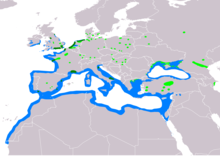Black-headed gull
| Black-headed gull | ||||||||||||
|---|---|---|---|---|---|---|---|---|---|---|---|---|

Black- headed Gull ( Ichthyaetus melanocephalus ) |
||||||||||||
| Systematics | ||||||||||||
|
||||||||||||
| Scientific name | ||||||||||||
| Ichthyaetus melanocephalus | ||||||||||||
| ( Temminck , 1820) |
The black- headed gull ( Ichthyaetus melanocephalus , Syn .: Larus melanocephalus ) belongs to the gulls within the order of the plover-like .
features
The black-headed gull is a relatively small species of gull with a length of 39 centimeters and a wingspan of 98 centimeters. It is nevertheless strongly built and has a large, round head. It reaches a length. The neck is very short. Their long, pointed wings protrude far beyond the fan-shaped tail. The feet have one short and three long toes that are webbed. The seagull's beak is short but strong. In her splendid dress she has a striking, black hood that extends down to the neck. The black-headed gull , similar in its splendid dress, has a dark brown hood that only extends to the back of the head. The wings are light gray, but the hand wings are white. The rest of the plumage is also white. Their feet and beak shaft are dark red, the tip of the beak is usually yellow to orange, but can also be red. There is a dark band between the tip of the beak and the beak shaft. The black hood is missing in the simple dress , but there is a dark gray spot behind the eye and gray lines on the back of the head. In the youth dress, the arm wings are colored brown, the shoulder feathers, however, are gray and the hand wings like the tip of the tail are black-brown. The neck, chest, and back of the head are pale gray-brown in color. The feet are slate gray, the gray-pink beak has a dark tip. From the second winter onwards the bird resembles the fully grown animal, but individual black feathers remain on the wings of the hand until this time. The feet are orange and the beak is colored like that of the adult birds. A red lid ring frames the eye, in front of which there are two white and naked eye spots. When young, the black-headed gull resembles a common gull of the same age.
Way of life
The black-headed gull mainly eats fish , mollusks , crustaceans and insects , which it looks for in the fringes of the beach. But it also feeds on carrion . Her nasal and deep calling sounds like gaääh or kau and kiau . This species usually breeds sporadically between other seabirds such as black-headed gulls and terns , but also in colonies on lakes, in swamps and on overgrown dunes by the sea. They sometimes mate with black-headed or common gulls . Between May and June, the female lays 2–3 yellow-brown, dark-spotted eggs in a cone-shaped nest with a deep hollow of earth, grass , algae and twigs. Both partners take turns breeding for about 24 days. The boys wear a gray down dress covered with dark dots . They are fed with choked and pre-digested food, fledged after about 25 days, but remain at the breeding site for a few more weeks. The black-headed gull becomes sexually mature at one to two years.
Habitat and Distribution
The black-headed gull usually lives on coasts, but sometimes also flies inland.
In southern Europe it is a fairly common breeding bird, in Central Europe, however, it is only distributed sporadically. It occurs in southern England , southern and northwestern France , northern Germany , the Netherlands , Turkey , eastern Greece , Croatia , Serbia , southwest Belarus , northern Poland , Latvia , Lithuania , on the Crimean peninsula and on the eastern coast of the Black Sea .
The first breeding record was made in Bavaria in 1980, after which it has spread further here and is considered a very rare breeding bird. It had its largest population in 2009 at Altmühlsee with twelve breeding pairs.
Outside of Europe it can be found in North Africa , Central Asia , the Middle East and on the Arabian Peninsula . Some birds migrate to the Mediterranean in autumn , some stay in their breeding grounds. The black-headed gull is thus a partial migrant .
Duration
The global black-headed gull population is estimated at 570,000 to 1.1 million individuals (Wetlands International 2002) . The black-headed gull population is not considered endangered and is given by the IUCN as Least Concern .
swell
Individual evidence
- ↑ Thomas Rödl, Bernd-Ulrich Rudolph, Ingrid Geiersberger, Kilian Weixler, Armin Görgen: Atlas of the breeding birds in Bavaria. Distribution 2005 to 2009 . Verlag Eugen Ulmer, Stuttgart 2012, p. 106
- ↑ Larus melanocephalus in the IUCN Red List of Threatened Species . Retrieved November 19, 2011. - Note: The IUCN uses an outdated nomenclature for this species.
literature
- Karel Šťastný: Birds Handbook and Guide to the Birds of Europe . Bechtermünz Verlag im Weltbild Verlag GmbH, Augsburg 1997, ISBN 3-86047-737-4 .
- Peter H. Barthel, Paschalis Dougalis: What is flying there? Franckh-Kosmos Verlags GmbH & Co. KG, Stuttgart 2006, ISBN 3-440-08160-5 .
- Hakan Delin, Lars Svensson : Birds. Franckh-Kosmos Verlags GmbH & Co., Stuttgart 2004, ISBN 3-440-09711-0 .



